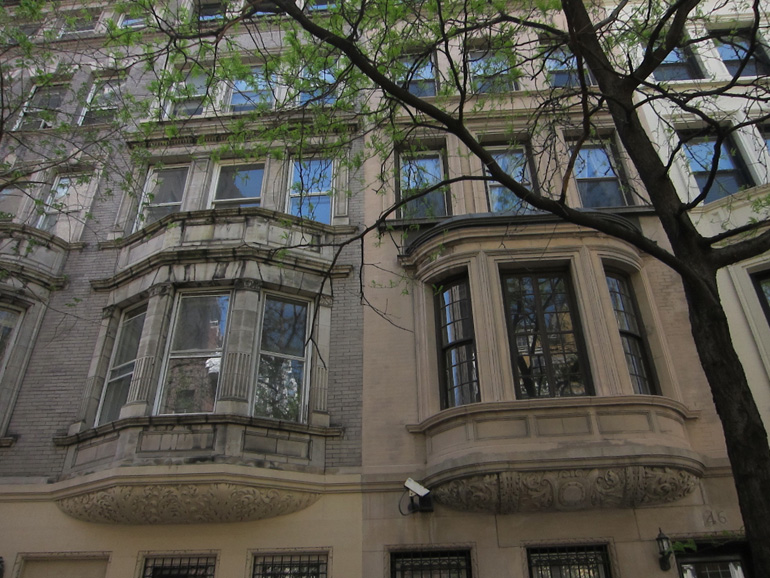Gotham Diary:
Betty and the Brontës
30 April 2012
There is still a good chance that I’ll get to the job that I’d planned to start after lunch: straightening up the refrigerator. It’s truly a job that I would almost do anything else to postpone, but I really couldn’t not sit down first and say a word about A Game of Hide and Seek, which I continued reading after lunch, and soon actually finished. It’s the ninth of Taylor’s novels that I’ve read — all the ones that you can buy off the shelf in the United States. The three remaining titles have been ordered by Crawford Doyle, and I can’t decide whether I hope that they arrive before I leave for Amsterdam and London at the end of next week. Also ordered, Nicola Beauman’s biography, The Other Elizabeth Taylor, which revealed the extramarital affair that Taylor had for many years with a painter whom she met at a Communist Party meeting.
I’ve read nine books, more or less in a row, by the same author, expecting, at the beginning of each one, to find my appetite sated by familiarity, but that has never happened, and in every case I’ve been sucked into the new story quite as compellingly as if I weren’t out to read everything by the author. Formally, the books are hugely different. None of the others, for example, has Hide and Seek‘s twenty-year narrative caesura; nor does any of the other books (that I’ve read) focus so intently upon a single attachment, which could be called the love story of Harriet and Vesey if that were not exactly what Hide and Seek Isn’t. The first half of the book takes place in the late Twenties; Harriet and Vesey have only just ceased to be children. Neither knows how to behave with the other. Harriet is painfully shy, and not only that: love seems to cause her real pain (which doesn’t make it any less desirable). Not the kind of agony that Derek Parfitt uses as the test for his propositions, assuming that we would do anything to avoid it and, if we were good, anything to spare others its misery, but pain nonetheless; you wouldn’t know to look at her that she’s in love. And Vesey is an impertinent, insistent autodidact, determined to learn nothing from anyone. The last days of their last childish summer together come to a Tennysonian sunset, and, after a spell of working in a dress shop, Harriet marries somebody else, a solicitor of substance whose mother used to be a star of the West End.
Then comes the break, and everything has changed when Vesey and Harriet meet at a dance as adults. For one thing, they know how to express the fact that they were in love and have never stopped loving the other — and they do so without talking. Tables have turned: Harriet is a proper provincial matron (High Wycombe?), while Vesey is an itinerant supporting actor (he plays Laertes when Hamlet comes to town). You wouldn’t think it possible, but the novel takes a turn towards Verdi territory when Harriet’s husband, Charles, decides not only to be jealous but to throw scenes. (“No woman,” Harriet reflects, “could have bided her time, as he had.”) There’s a sensational ensemble number with Charles and his dodgy law partner and the law partner’s dodgy wife (who thought that the “worse” in “for better or worse” would be her husband, nothing additional) standing about like aristocrats in Don Carlo or Otello, while Harriet drops a crystal glass, kneels to gather the fragments, cuts her self, and is swiftly joined by Vesey, who wraps her bleeing wound in a handkerchief, oblivious of the others. It’s the most exuberantly thrilling scene that I’ve ever read in any novel — any novel that wasn’t supposed to be thrilling, that is. You can’t believe that it’s happening in an English drawing room round about the time I was born.
Taylor follows this with the most extraordinary leap. Skipping over the lovers as if they weren’t there, she writes about Charles’ invigoration: having a grievance against his wife puts a spring in his step.
His attitude toward his mother was part of the change. Now he talked of her a great deal — as she had been as an actress, and strove to remember some of those successes which at the time he had resented. He seemed all of a sudden to know a great deal about the stage without everr having gone much to the theatre. A photograph of Julia as Cleopatra, with hair low on her brow, looped and strung about with pearls and looking bad-tempered, was discovered among some old letters and left propped on his desk. He often spoke of her precarious and arduous life, although she had been, as he said, at the very top of her profession.
Julia herself, the old ageing vamp, finds “a new lease on life” in her turn, as the direct result of Charles’s new affection. So does that of the granddaughter who takes after her, despite her fanciful dream that Vesey, and not Charles, is her father. (The truth is betrayed by an unconscious gesture right out of Julia’s playbook.) Only gradually do we come back to Harriet, or rather to what is now her Big Problem: how to remain respectable whilst being in love with another man. (And she is no longer pained by Vesey; he makes her happy now, as nothing else does.) I won’t go into any of this, except to say that Taylor assumes that the reader has read a few other novels and perhaps even seen a few movies (including one that rouses Julia’s indignation, involving “a middle-aged couple in raincoats, and it all took place on a railway-station”) and, in short, manages to convey Harriet’s first-time, I’ve-never-done-this-before panic without trying your patience. The end is quick and fine.
***
Now I’d better get Nescio under my belt, hadn’t I.

